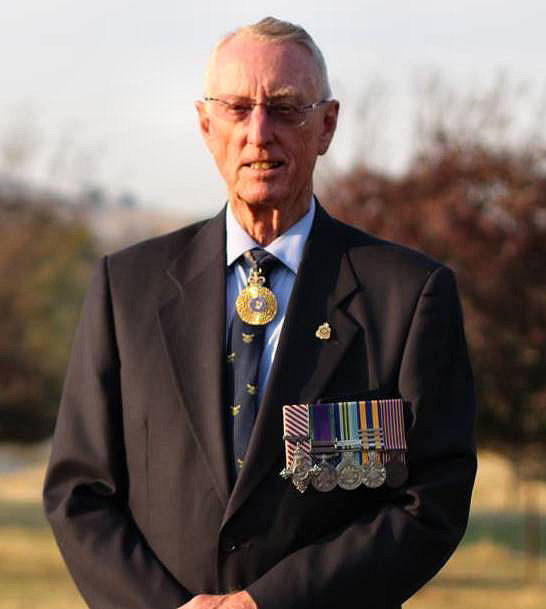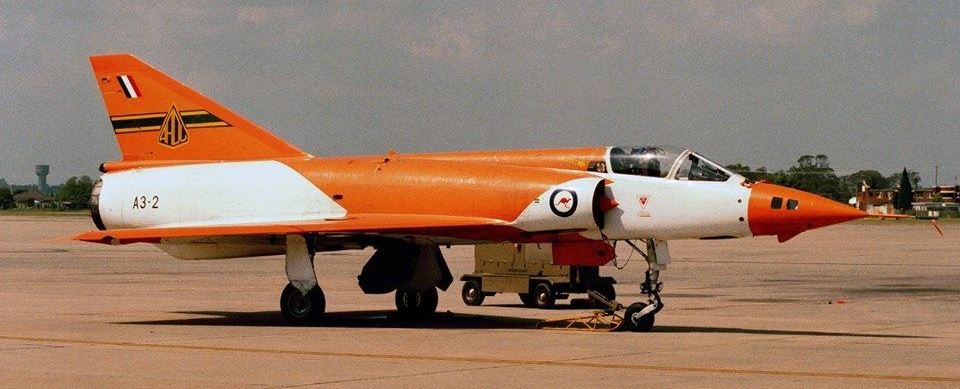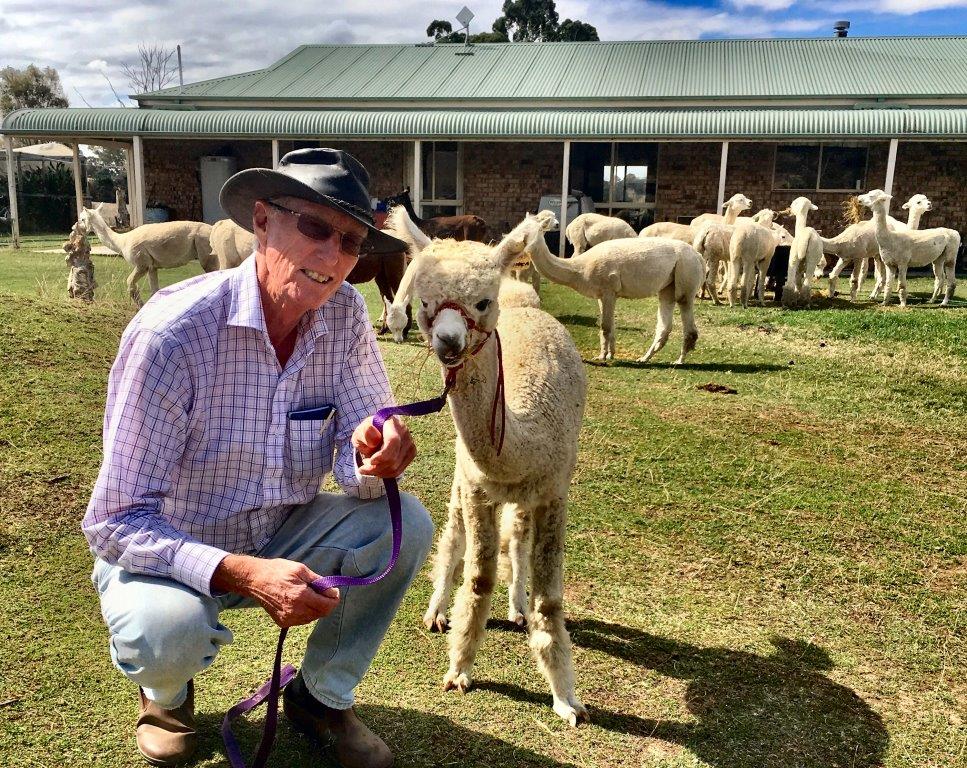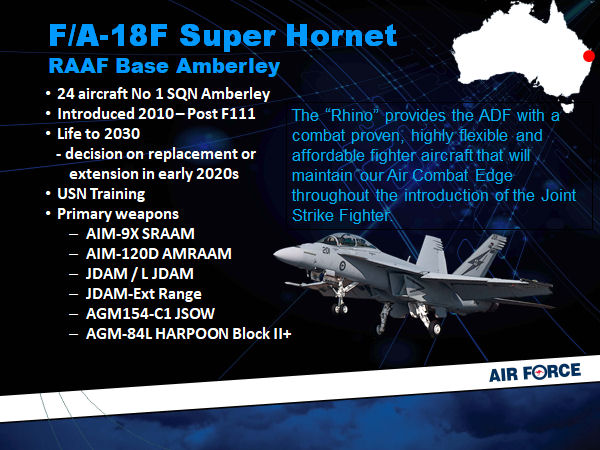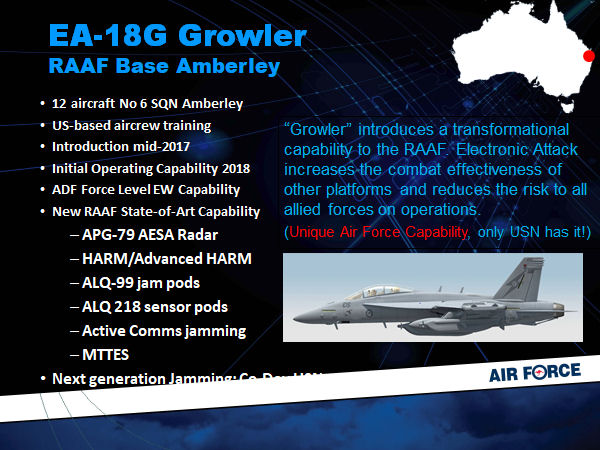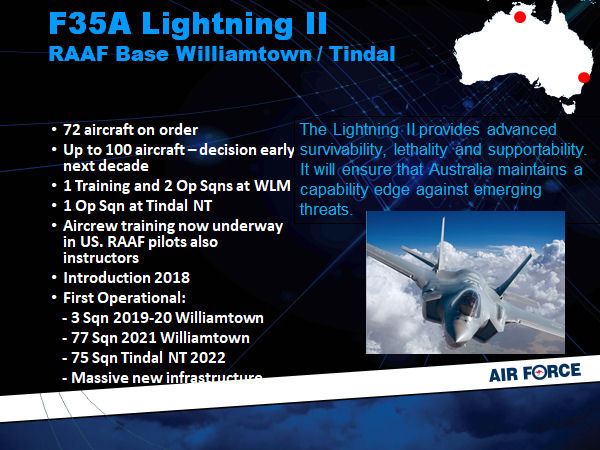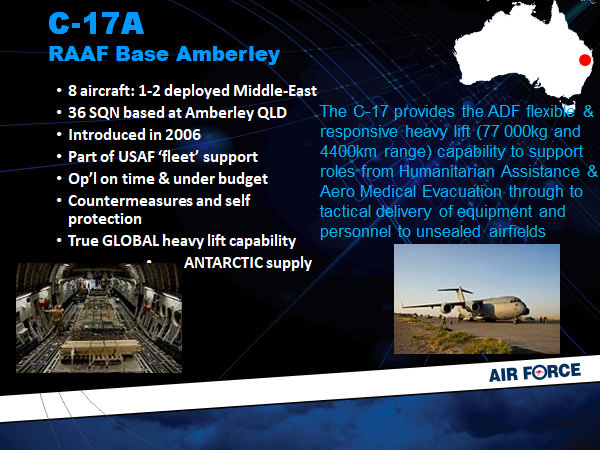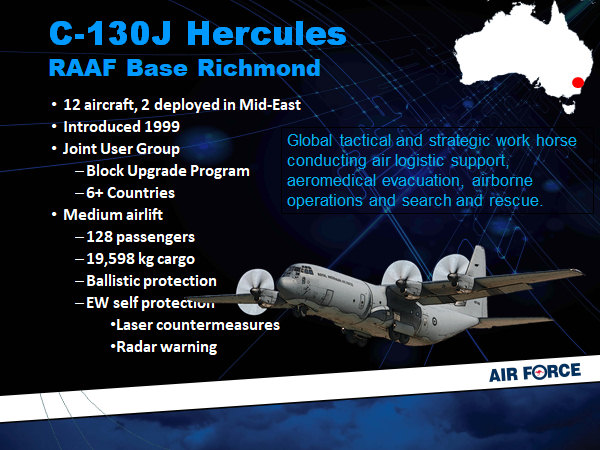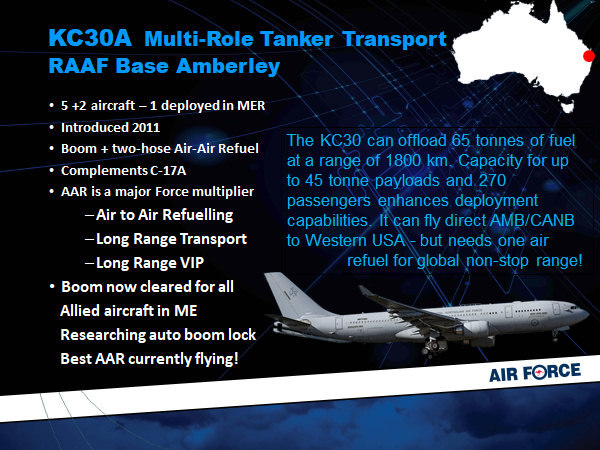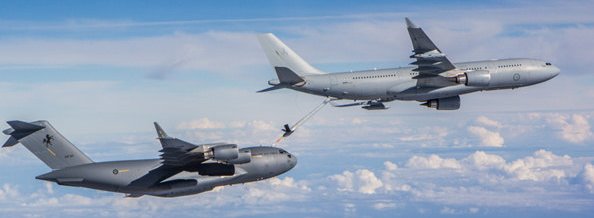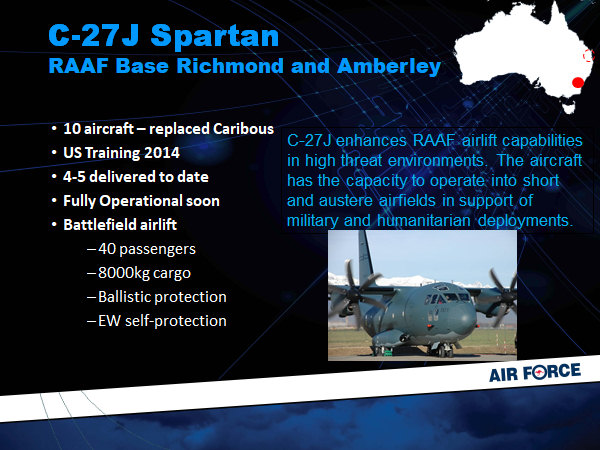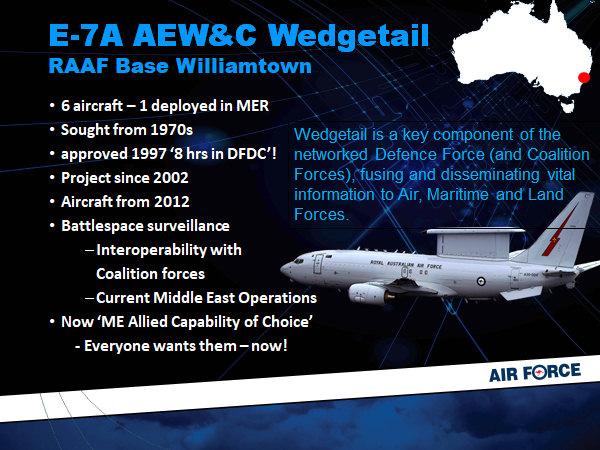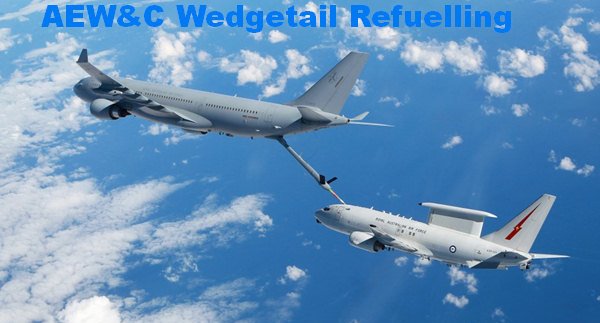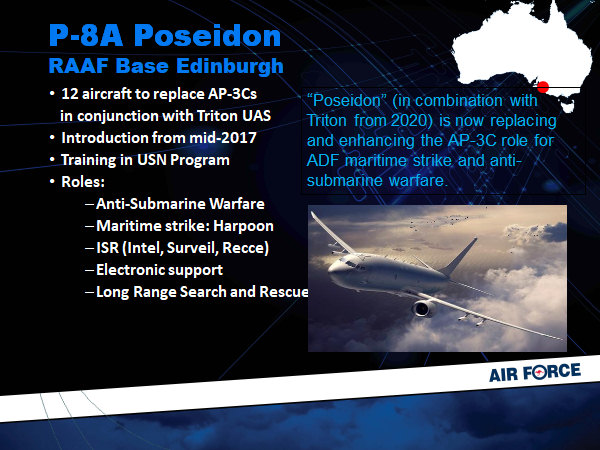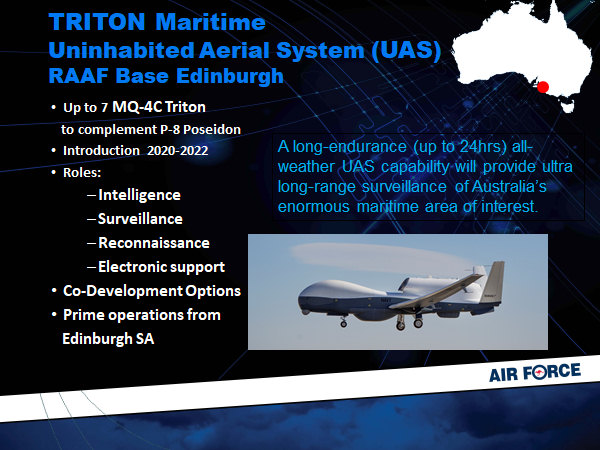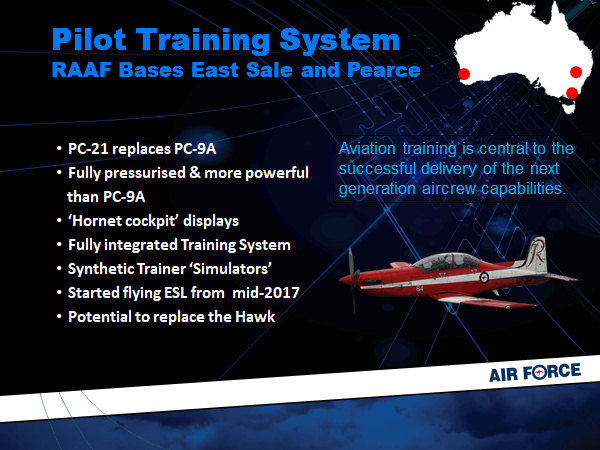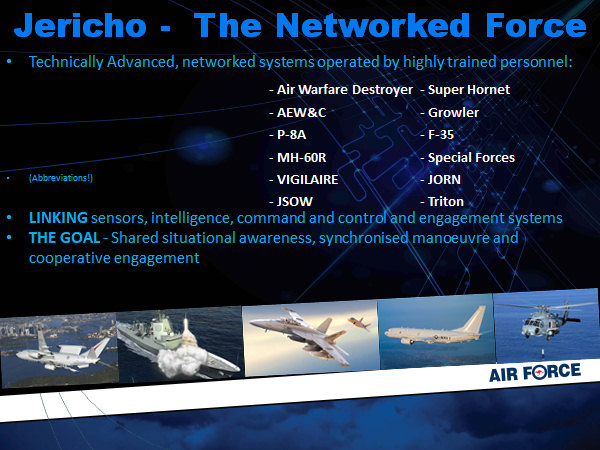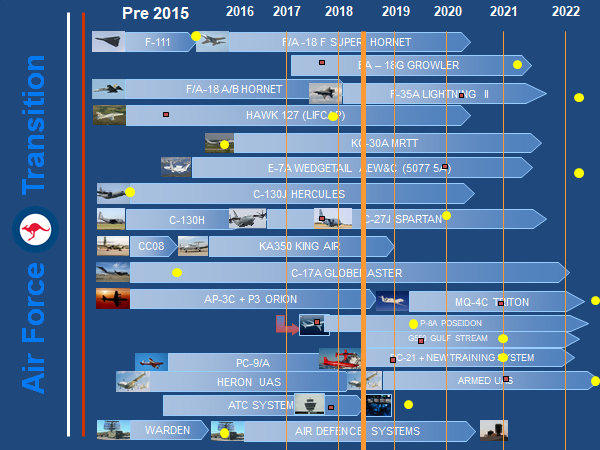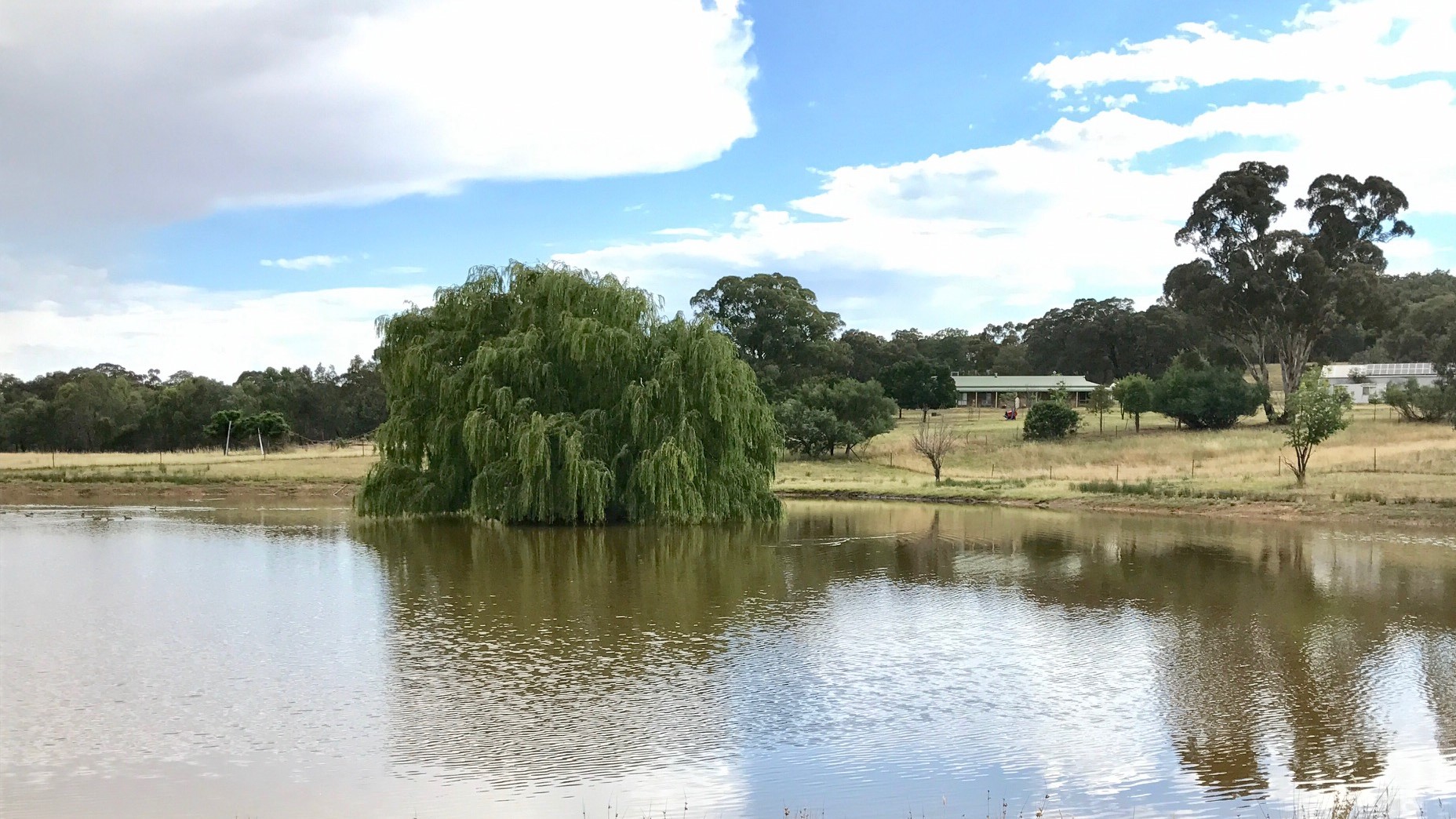|
|
||
|
||
|
Privacy Policy | Editorial Policy | Profit Policy | Join the Association | List of Members | Contact us | Index | Links |
||
|
Back Go to page: 1 2 3 4 5 6 7 8 9 10 11 12 13 14 15 16 17 18 19 20 Forward
|
||
|
Our Air Force - one of the Best!!
Back in April this year, Air Vice-Marshal Bob. Richardson, AO AFC RAAF (Ret’d) gave a presentation at the Australian Aviation Club in Canberra.
Bob argued that today’s RAAF, although not the biggest is certainly one of the best equipped Air Forces in the world - and he should know! Bob flew over 5000 hours in 25 different RAAF, Army and foreign military aircraft and has 250 hours in sailplanes. In 1995 he was appointed as a Fellow of the international Society of Experimental Test Pilots and he was also made an Officer in the Order of Australia in that year. He was Australia’s most experienced test pilot.
Born in Victoria and brought up on soft fruit, dairy and poultry farms, Bob started his working life as a laboratory assistant and although he gained a Diploma in Chemistry, he only had eyes for the sky and constantly poured all his spare money into learning to fly. He joined the RAAF and was selected for No. 43 Pilots Course in 1961 and after 15 months of training he was given his wings and was selected to go to Newcastle for fighter training. He went on to fly Sabres with 77 and 79 Squadrons, spending a total of 3 years in Malaysia, Singapore, Thailand and Borneo during the Indonesian Confrontation crisis.
Returning to Australia, he completed a tour as flying instructor at No. 1 BFTS at Point Cook, then in 1968 he was selected to attend the famous Empire Test pilots School in England after which followed four separate periods totalling nearly 14 years at ARDU at Laverton as an experimental test pilot. He was Chief Test Pilot for five years and later commanded the Unit in 1986-87.
Highlights during his test flying career included:
On one test flight in August 1972, Bob was forced to eject from a Mirage following engine failure. He says he’s a bloke with 9 lives, the Mirage was only at 600 feet when he had to leave it and he readily agrees that he owes his life to the Martin-Baker company. He did suffer some injuries during the landing, there was a 35 knot wind blowing and he hit the ground at a rapid rate of knots.
Later while in command of ARDU’s Flight Test Squadron, Bob was attached to Air Force Headquarters for lengthy periods between 1979 and 1981 as the chief test pilot on the evaluation of new fighter aircraft, culminating in the selection of the F/A-18. He evaluated the Mirage 2000, F16A/B, Northrop F-18L and several early F/A-18 prototypes and was later awarded the Air Force Cross for this work.
Over the next 15 years Bob spent periods in Defence Strategic and International Policy formulation, attended the Royal College of Defence Studies in London in 1991 and was appointed RAAF Training Commander 1992-93. He was then appointed as the military co-author of the 1994 Government Defence White Paper ‘Defending Australia’, following which he was promoted to Air Vice-Marshal in February 1995 and appointed Chief of Air Force Personnel and Budget. After a period as Deputy Chief of Air Force he transferred to the RAAF Reserve in June 1997.
He then spent two years carrying out a major review of the three Service arms of the ADF Cadet Scheme, with a civilian colleague for the Minister for Defence Personnel. The major recommendations of this review, including re-naming the three organisations and greatly improved administration and funding were fully accepted and implemented. He also spent several years working as a Consultant with British Aerospace PLC.
Flying runs in the family, his father, Flt Lt William Yorke Richardson DFM DFC, was an RAAF Torpedo Beaufighter pilot who completed two operational tours in 254 Squadron RAF in the Second World War, including long periods as an ATDU weapons test pilot flying 12 aircraft types including the Lancaster, Boston, Firebrand and Typhoon, mainly on torpedo, aerial mine and depth-charge development.
Bob developed his love of flying in his teenage years and began gliding when he was 16. He went solo long before he could drive a car.
|
||
|
|
||
|
These days he farms alpacas on a 48 hectare property near Yass in NSW and is actively involved in alpaca fleece industry development as well as local Legacy and RSL activities.
|
||
|
I read that, by law, you have to turn on your headlights when it’s raining in Sweden. How the hell am I supposed to know if it’s raining in Sweden?
|
||
|
With such a background, Bob was supremely qualified to propose such a presentation subject.
He says:
|
||
|
|
||
|
“I make that bold claim and I’m going to try to convince you that it’s valid. I never imagined that in retirement I would one day stand before my peers and claim that the Royal Australian Air Force, approaching 100 years old, now has the best air combat and supporting capabilities in the world – and I include the USAF and USN in that comparison.
So, drawing on my other privilege of being invited over many years, with some others here, to visit RAAF bases annually for briefings on current capabilities, I’ll now remind you of some of them. And I’m going to skip over my favourite aircraft, the Classic Hornet – with its incredible record of 33 years in service with no loss due to technical cause: all four we’ve lost have been through operator mishap - a unique operational record!
F/A-18F Super Hornet
The Air Force has 24 F/A-18F Super Hornets, all at 1 Sqn Amberley. Their last combat deployment was to Operation OKRA in the Middle East which ended in December 2017.
|
||
|
|
||
|
The twin seat F/A-18F Super Hornet can undertake:
It has 11 external hardpoints: 2 wingtips, 6 under-wing, and 3 under-fuselage, allowing 8 tonnes of external fuel and ordnance.
In the last 3 years the RAAF has spent $534m on some of its weapons, including:
Finally, the Super Hornets have the M61 6-barrel cannon, firing 20mm HE at 6000 rounds per minute.
|
||
|
EA-18G Growler.
12 EA-18G Growlers entered RAAF service last year with 6 Sqn Amberley. Australia is the only country outside of the US to be granted access to this aircraft. It is very similar to the Super Hornet, with a 90% compatibility but for greater EW mission stability Boeing modified leading edge and wing fold fairings and added wing fences and aileron "tripper strips". Most of the airborne electronic attack equipment is mounted in the former internal cannon compartment.
|
||
|
|
||
|
The Electronic Warfare systems include ALQ-218 wideband receivers on the wingtips and ALQ-99 high and low-band tactical jamming pods. These two systems form a full spectrum electronic warfare suite to provide detection and jamming against all known surface-to-air threats. But, more importantly, the Growler is the first fighter to use its active APG-79 AESA electronically scanned array radar for electronic attack, with a software upgrade to allow the array of transmitter modules to be used as a powerful directional jammer. Under sensor integration, the radar is linked to the ALR-67 radar warning receiver via the Growler's fibre-optic network and the radar's ground mapping capability is then used to pinpoint detected emitters.
The ALQ-214 ECM suite is also integrated so the aircraft can jam emitters through its AESA radar. (An active electronically scanned array (AESA), is a type of phased array antenna, that is a computer-controlled array antenna in which the beam of radio waves can be electronically steered to point in different directions without moving the antenna.)
The Growler can be fitted with up to five jamming pods programmed for different threats and will typically add two AIM-120 AMRAAM self defence missiles and two HARM attack missiles.
Lastly, very important is the INCANS Interference Cancellation system that allows voice communication while jamming enemy comms!
|
||
|
F-35A Lightning.
We've committed to 72 F-35A aircraft for three operational squadrons at Williamtown and Tindal and No. 2 Operational Conversion Unit at Williamtown. 3 Sqn be the first to receive the aircraft next January (2019), the others each following year. It's hoped a fourth operational squadron will be considered next decade for Amberley, for a total of 100 F-35As.
|
||
|
|
||
|
3 squadron pilots, who will bring the aircraft to WLM in December or January 2019 are now flying the first 6 F-35As with a US training squadron. 3 Squadron will be fully operational in 2021 and all 72 aircraft will be operational by 2023.
The F-35A is characterised by its low profile design, internal weapons and fuel carriage, APG-81 AESA radar, electro-optical and infrared sensors, advanced voice and data link communications, and the ability to employ nearly all the air-to-surface and air-to-air weapons mentioned previously, most in its internal weapon bay. It's capable of supersonic flight without afterburner and has excellent acceleration and 9G manoeuvrability.
But it’s the SYSTEMS that provide the Lightning’s real combat capability! For example - the AAS-37 electro-optical Distributed Aperture System provides F-35 pilots with a unique protective sphere around the aircraft for missile warning, navigation support and night operations. This unique 360 degree, spherical situational awareness system, has six high resolution IR (infra-red) sensors mounted around the airframe to provide unobstructed spherical coverage and functions around the aircraft without any pilot input or aiming required. It warns the pilot of incoming aircraft and missile threats, as well as providing day/night vision, fire control capability and precision tracking of wingmen and friendly aircraft for tactical manoeuvring. It also supports the navigation function of the Lightning's forward-looking infrared sensor.
So, the key Lightning features are its advanced sensors:
|
||
|
C-17A Globemaster III
The C-17A Globemaster III now provides the Air Force with a world-wide capability for strategic airlift. It allows Australia to rapidly deploy troops, supplies, combat vehicles, heavy equipment and helicopters anywhere.
|
||
|
|
||
|
Based at Amberley, all eight C-17As are operated by No. 36 Squadron and provide a logistics backbone for Australian Defence Force operations overseas. It can operate from unsurfaced runways as short as 3500 feet/1100m.
With a max take of weight (MTOW) of 265 tonnes, the C-17A can carry up to 77 tonnes of cargo, and carry loads ranging from an Abrams Tank, four Bushmasters, or three Black Hawk helicopters for ranges from 2,400 to 5,600 nautical miles unrefuelled. It can also be converted for medical rescue.
36 Squadron has delivered large loads to our Antarctic airfield near Casey Station, and has also air-dropped a load there in winter.
Our C-17s have the latest LAIRCM Large Aircraft Infrared Countermeasures system, AAR-47 missile warning system and ALE-47 flare dispenser.
|
||
|
C-130J Hercules.
There’s not much more to say about our last squadron of Hercs, the great workhorse that transformed RAAF transport capability from the Dakota era in the 1960s.
|
||
|
|
||
|
Most of us will have flown in it, some more times than we care to remember, others perhaps when 86 Wing provided a memorable airline service Australia-wide for a period.
Of my many trips in it, I’ll always remember an overnight Joint Staff College return from Bangkok to Canberra via the South Australian Bite, cruise-climbing with all the floor heating unserviceable…!
|
||
|
KC30A Multi-Role Tanker Transport.
The KC-30A Multi-Role Tanker Transport is a heavily modified Airbus A330-200 airliner for air-to-air refuelling and strategic air lift. It has advanced communication and navigation systems, and EW self-protection against missile threats.
|
||
|
|
||
|
Two more KC-30s are being delivered this year, bringing the fleet to seven at 33 Sqn Amberley. These two are former Qantas A330-200s, now being converted to tankers and one of them will have a VIP fit-out with meeting room and VIP comms facilities in the forward Business section - but will primarily remain as a tanker. The last White Paper planned to increase the KC-30 fleet to nine to support new RAAF aircraft such as the P-8A Poseidon.
The KC-30A Boom System and two electric refuelling pods under each wing are controlled by an Operator at the rear of the cockpit, who views refuelling on 2D and 3D screens. I had the opportunity last November to plug the boom into a C-17 in the impressive 33 Sqn refuelling simulator…
It can carry a fuel load of more than 100 tonnes and transfer much of that to compatible aircraft, including all of our Hornets, the E-7A Wedgetails, the C-17A Globemasters, the P-8A Poseidons, and the F-35A Lightnings. And, of course, it’s now routinely refuelling many allied aircraft in the Middle East, such as F-16s, B2s, Tornados, and the French combatants, etc. Our KC-30 is widely regarded as the best tanker in the world and is clearly superior to the somewhat troubled new USAF aircraft.
|
||
|
|
||
|
The KC-30A can remain 1800 km from its home base for up to 4 hours to offload 50 tonnes of fuel. It can also carry 270 passengers, and 34 tonnes of freight in pallets and containers.
|
||
|
C-27J Spartan.
Supplementing the Hercules and Globemaster, the C-27J Spartan battlefield airlifter can airdrop cargo and paratroops, typically airlift cargo or up to 34 passengers; conduct aeromedical evacuations with 21 stretchers; operate from unsurfaced strips, and support humanitarian missions in remote locations.
|
||
|
|
||
|
The first Spartan arrived in 2015, to be operated by No. 35 Squadron at Richmond. The last of ten have now arrived and the squadron will relocate to Amberley next year (2019) when permanent facilities are completed.
The C-27J complements the ADF’s existing air mobility fleet, bridging the gap between Army’s helicopters including the CH-47F Chinook and larger Air Force transports such as the C-130J and C-17A. With a max T/O weight of 30.5 tonnes the C-27J can carry up to 11.5 tonnes, more than twice the old Caribou’s loads, into similar restricted airfields and it has a range of 2200nm with 6 tonnes payload. Its service ceiling is 30,000 ft.
|
||
|
E-7A Wedgetail.
|
||
|
The E-7A Wedgetail now provides Australia with the most advanced air battlespace management capability in the world. Based at Williamtown, our six E-7A Wedgetails fundamentally increase the effectiveness of the ADF. They provide air control from the sky and can cover four million square kilometres during a single 10-hour mission.
|
||
|
|
||
|
The Wedgetail is based on a Boeing 737-700, with the most advanced Multi-Role Electronically Scanned Array (MESA) radar currently in-service, operating at ranges over 200 nautical miles. This airborne early warning and control platform can gather information from a wide variety of sources, analyse it, and distribute it to other assets – to control the tactical battle space; provide direction for assets in the air, at sea and on land; and support other aircraft such as tankers and intelligence platforms.
Its 10 state-of-the-art mission crew consoles can track airborne, maritime and other targets simultaneously and its comms systems include HF, VHF, UHF, Link-11, Link-16, and UHF SATCOM. EW self-protection measures include directed IR counter-measures, chaff and flares
|
||
|
|
||
|
Currently deployed on Operation OKRA, it is routinely thought of as definitely the allied AEW&C capability of choice. E-7A unrefuelled range is 3,800 nautical miles or 7000km.
|
||
|
P-8 Poseidon.
The P8 Poseidon is the West’s newest maritime surveillance aircraft. Its use is to support:
|
||
|
|
||
|
Both the USN and the RAAF plan Poseidon to operate with the support the MQ-4C Triton unmanned aircraft system. The Poseidon will replace the ageing AP-3C Orions, and uses state-of-the-art sensors and mission systems, including advanced multi-role radar, high definition cameras and an acoustic system with four times the processing capacity of our AP-3Cs.
Six of the twelve 11Sqn Poseidons are now at Edinburgh; the last will arrive by March 2020 with a possible additional 3 aircraft later next decade.
The P-8A is built as a military aircraft, based on the proven Boeing 737-800ER, but structurally modified to include a weapons bay, under-wing and under-fuselage weapon hard points, as well as strengthening for low level operations to 200 ft. The comms suite includes radios and data links across the VHF, UHF, HF and SATCOM spectrums.
An internal fuel capacity of almost 34 tonnes gives the P-8A 6 hours mission endurance at a range of 600nm from base, and 4 hours at 1200nm range. It is boom air-refuellable.
The nose synthetic aperture radar and ISAR has a specialized Radar Detection and Discrimination mode to detect periscopes at long range. Inverse synthetic aperture radar (ISAR) is a radar technique using radar imaging to generate a two-dimensional high resolution image of a target.
Up to 120 sonobuoys are carried, deployed by two reloadable rotary pneumatic launchers. The Poseidon can carry five missiles, depth charges or torpedoes in a rotary launcher in the rear fuselage and six more on underwing racks. A new hydrocarbon sensor detects fuel vapours from diesel-electric submarines.
The MK 54 lightweight torpedo is the main ASW weapon. The P-8 can also use a special High Altitude Air Launch Accessory to turn its Mark 54 torpedoes into GPS-guided glide bombs that can be dropped from up to 30,000ft. These shed their wings on hitting the water and home on targets using on-board sonar.
Poseidons can also carry Harpoon AGM-184H/K anti-ship missiles with a range of 150 miles. (My personal opinion is that we should clear other long-range weapons using those external hard points – because the knowledge of that platform potential would greatly complicate an adversary’s tactical planning on the basis of the Poseidon’s very long range with AAR and ability to network with eg JORN, Wedgetail, Triton and the other combatants for protection!).
|
||
|
MC-4C Triton Un-manned aircraft.
The MQ-4C Triton Unmanned Aircraft System is a High Altitude Long Endurance (HALE) aircraft that will be used from 2020 for maritime patrol and other surveillance roles. Supporting missions up to 24 hours, the Triton is equipped with a sensor suite that provides a 360-degree view of its surroundings for over 2000 nautical miles.
|
||
|
|
||
|
Seven Tritons will be based at Edinburgh and will operate alongside the P-8A Poseidon to replace the AP-3C Orions. The endurance of the Triton means that it can stay airborne for longer than any crewed aircraft. It will be flown by two qualified Air Force pilots from a ground station and information gathered will be analysed and communicated by operational staff such as aircrew, intelligence, operations and administration officers, engineers, and logisticians (depending on the training or mission requirements).
The Triton has de-icing and lightning protection systems that allow it to descend through cloud to gain a closer view of ships and other targets at sea, complementing the Poseidon.
It can remain aloft for more than 30 hours at 55,000 ft and fly at speeds up to 330 knots. Its surveillance sensor is the ZPY-3 MFAS Multi-Function Active Sensor X-band AESA radar with a 360-degree field-of-regard, capable of surveying 7,000,000 square km of ocean, as well as shoreline or land, or 5,200 square km in a single sweep.
|
||
|
PC-21 Trainer.
Although similar in appearance to the current PC-9 trainer, the new PC-21 is a far superior aircraft.
|
||
|
|
||
|
The first six of 49 Pilatus PC-21 advanced trainers were delivered to East Sale last August (2017). From 2019 the PC-21s will replace the current Pilatus PC-9/As and the CT-4B Airtrainers which are currently used for basic training. 42 of the new PC-21s will be used for both basic and advanced ADF pilot training at Basic Flying Training School, BFTS, which is relocating from Tamworth to East Sale. BFTS will join the QFI training conducted by Central Flying School and its Roulettes formation display flying. 2 Flying Training School will remain at Pearce, WA.
The PC-21 is a very advanced military trainer and it will potentially replace the BAE Hawk for basic strike fighter training next decade. The current contract includes sophisticated procedural and training simulators.
The PC-21 has a pressurised cockpit with full digital displays similar to the Hornet HOTAS system, air conditioning, an anti-G system and on-board oxygen generation. It has a 1,600 shaft horse power Pratt & Whitney Canada PT6A-68B turboprop engine and 5-blade prop, digital power management and horizontal stabiliser with automatic yaw compensation for engine power and speed changes. These enable low altitude speeds over 320 knots and hydraulically assisted ailerons and roll spoilers produce rates of roll over 200 degrees per second. It's stressed for manoeuvring up to 8g.
|
||
|
Jericho - The Network.
Plan Jericho is the plan to transform the RAAF into a fighting force that brings together all the high technology systems now being introduced. It's an ambitious plan to develop and maintain one of the most technologically advanced air forces in the world over the next decade.
|
||
|
|
||
|
We cannot be complacent by thinking that simply having the next generation of aircraft technology will create an advanced air force. Full potential with the E-7A Wedgetail, the F-35A Lightning II, F/A-18F Super Hornets, EA-18G Growler, P-8A Poseidon and MQ4C Triton can only be reached through operating them in a fully networked force, including the Army and Navy. We need to transform ourselves into a truly integrated and networked force that can realise the potential of this technology, and maintain our position as masters of the air domain.”
Defence needs unprecedented access to the deep research and development capacity of private industry. Private industry has driven advancement in communication technology and big data management. It is frustrating that our war-fighters are not able to exploit this technology in their work environments to the same extent that they do in their private lives. It is alarming to see our adversaries are not similarly constrained.
|
||
|
|
||
|
The pic above shows where the Air Force is now in its capability transition.
Not mentioned is the enormous investment in RAAF Base facilities to house and maintain the many new capabilities; in particular at Williamtown, Edinburgh, East Sale and Tindal.
Amberley facilities are almost complete now; and if you haven’t been there for a while, you will barely recognise the Base because of its enormous changes to accommodate support for the newer aircraft. One third of all RAAF uniformed people are now at Amberley which also houses a large Army and Contractor force.”
Bob retired from the RAAF in 1997, after serving for 36 years. He now lives on a property called Argyle Park, which is only 10 minutes from Yass where he raises alpacas. He’s only a bit over an hour from Canberra and keeps up to date on the RAAF’s coming and goings and is well versed in its current capabilities.
|
||
|
|
||
|
Argyle Park is well-developed as a show-piece alpaca stud, able to welcome visitors interested in a 'hands-on' experience with the alpacas. There are around 100 alpacas and a small flock of Dorper sheep on the property, together with a few chooks, many birds and rather too many rabbits. The kangaroos and a couple of wallabies 'come and go' and share the pasture without too much problem.
The many kilometres of native trees seeded in the late 1990s have grown to 5-15 metres and have greatly improved the property. Visitors are welcome to enjoy beautiful walks to see the birds in these trees, especially along the gully areas and around the lake.
Picnic and toilet facilities are available to visitors, as well as boiling water for a complimentary cup of tea and coffee.
If you’re in the area, drop in, Bob will make you more than welcome.
Click HERE to see more on Argyle Park.
|
||
|
I had a really bad day. First, my Ex got run over by a bus. Then I got fired from my job as a bus driver.
|
||
|
|
||
|
|
||
|
|
||
|
|

